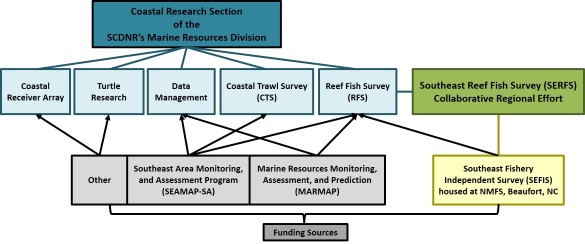Coastal Research Section
Coastal Trawl Survey, Reef Fish Survey, Data Management, Turtle Research, Coastal Receiver Array

The Coastal Research Section of the SCDNR’s Marine Resources Division houses several nearshore and offshore sampling programs that monitor South Carolina’s and the Southeast’s natural resources. The broader region where these surveys work commonly is referred to as the South Atlantic (the Atlantic Coast off the southeastern U.S.). The Data Management component of the Coastal Research Section has a primary focus on compiling data for several regional programs funded by the SEAMAP-SA. The remaining three components of the Coastal Research Section are sampling programs that monitor fish, invertebrates, and sea turtles: the Coastal Trawl Survey, the Reef Fish Survey, and the In-Water Sea Turtle Research survey.
The Coastal Trawl Survey samples nearshore, trawlable habitat (mostly sandy and muddy bottom) in state and federal waters from central North Carolina to central Florida. Their trawls catch a variety of species such as spot and croaker, sharks and rays, mackerel, many species of invertebrates, and even turtles. The Coastal Trawl Survey has been funded by the Southeast Area Monitoring, and Assessment Program - South Atlantic (SEAMAP-SA) since 1986.
The Reef Fish Survey samples offshore, hard bottom habitat (rocks, boulder, or ledges with attached corals, sponges, algae) within federal waters from central North Carolina to southern Florida. They use traps and bottom longlines to catch a variety of snappers, groupers, porgies, and tilefishes. The Reef Fish Survey was funded solely by the Marine Resources Monitoring, Assessment, and Prediction (MARMAP) program from 1972 to 2009. Since 2010, the Reef Fish Survey has been part of a collaborative group called the Southeast Reef Fish Survey (SERFS) funded by MARMAP, SEAMAP-SA, and the Southeast Fishery Independent Survey (SEFIS) which is housed at the Southeast Fisheries Science Center, National Oceanic and Atmospheric Administration.
The primary mission of the Turtle Survey is to monitor temporal and spatial changes in the distribution, relative abundance, demographic structure, and health of sea turtles captured by trawling in coastal waters between South Carolina and north Florida. Five of the world’s seven species of sea turtle have been captured in this survey since inception in 2000, but two species (loggerhead and Kemp’s ridley) comprise 99% of all sea turtle captures to date. Data collected by this survey have been used to inform management decisions for these long-lived species that require decades to reach sexual maturity, and consequently, have remained protected under the Endangered Species Act for the past four decades. Similar data collection efforts in estuarine habitats (but using passively fished nets deployed and retrieved by hand) began for diamondback terrapins began in 2013 and for sea turtles in 2018.
The Coastal Receiver Array program monitors selected areas using submerged receivers that detect and record the presence of a wide variety of animals tagged with acoustic transmitters as they swim past. The presence data collected by these receivers provides managers with a sense of where and when species occur off SC, areas with disproportionate detection, and the ability to monitor changes in these distribution patterns over time in response to changing environmental conditions. Collection of this type of distribution data is valuable for interpreting trends in surveys that focus on catch rates for the same species.
